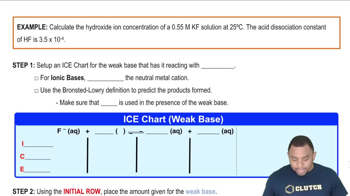Here are the essential concepts you must grasp in order to answer the question correctly.
Chemical Formula Interpretation
Understanding a chemical formula is crucial for identifying the components of a compound. In the formula Al₂(Si₂O₅)₂(OH)ₓ, each part represents different elements and their quantities. The subscript numbers indicate how many atoms of each element are present, which is essential for determining the overall composition of the mineral.
Recommended video:
Intepreting the Band of Stability
Hydroxide Ion (OH⁻)
A hydroxide ion (OH⁻) consists of one oxygen atom and one hydrogen atom, carrying a negative charge. Hydroxide ions are important in various chemical reactions, particularly in acid-base chemistry. In the context of pyrophyllite, the value of 'x' in the formula indicates the number of hydroxide ions present, which contributes to the mineral's properties.
Recommended video:
Hydroxide Ion Concentration Example
Stoichiometry
Stoichiometry is the calculation of reactants and products in chemical reactions based on the conservation of mass. It allows chemists to determine the relationships between different substances in a reaction. In this case, stoichiometry helps in calculating the number of hydroxide ions in pyrophyllite by analyzing the overall formula and the contributions of each component.
Recommended video:
 Verified step by step guidance
Verified step by step guidance

